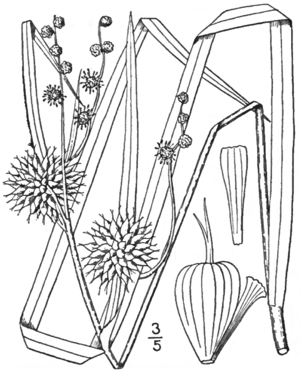An Illustrated Flora of the Northern United States, Canada and the British Possessions/Sparganiaceae
Family 2.
Sparganiàceae
Agardh,
Theor. Syst. Pl. 13.
1858.*
Bur-Reed Family.
Marsh or pond plants with creeping rootstocks and fibrous roots, erect or floating simple or branched stems, and linear alternate leaves, sheathing at the base. Flowers monoecious, densely crowded in globose heads at the upper part of the stem and branches, the staminate heads uppermost, sessile or peduncled. Spathes linear, immediately beneath or at a distance below the head. Perianth of a few irregular chaffy scales. Stamens commonly 5, their filaments distinct; anthers oblong or cuneate. Ovary sessile, mostly 1-celled. Ovules anatropous. Fruit mostly 1-celled, nutlike. Embryo nearly straight in copious endosperm.
________
* Text revised by Dr. John Kunkel Small.
¯¯¯¯¯¯¯¯
The family comprises only the following genus.
1. Spargànium [Tourn.] L. Sp. Pl. 971. 1753.
Characters of the family. [Greek, referring to the ribbon-like leaves.]
About 22 species, of temperate and cold regions. Besides the following, 3 others occur in western North America. Type species: Sparganium erectum L.
|
| ||||||||||||
| • | Achenes broadly obovoid or cuneate-obpyramidal, sessile, distinctly beaked; inflorescence compound; fruiting heads 10"-15" in diameter. | 1. | S. eurycarpum. | |||||||||
| • | Achenes fusiform (in S. minimum somewhat obovoid, but short-beaked and short-stipitate). | |||||||||||
| • | Stipe and beak of the achene each 1" long or more; fruiting heads 7½" in diameter or more; anthers 3-4 times as long as broad. | |||||||||||
| • | Beaks straight or slightly curved; stigmas linear. | |||||||||||
| • | Heads all axillary; beak shorter than the body of the achene; leaves keeled. | |||||||||||
| • | Achenes dull; stigmas 1" long or less. | |||||||||||
| • | Inflorescence branched, the branches geniculate, bearing 3-7 staminate heads. | 2. | S. androcladum. | |||||||||
| • | Inflorescence simple, or, if branched, the branches strict and bearing 0-2 staminate heads. | 3. | S. americanum. | |||||||||
| • | Achenes glossy; stigmas 1¼"-1¾" long. | 4. | S. lucidum. | |||||||||
| • | Heads, at least some of them, supra-axillary. | |||||||||||
| • | Leaves, at least the middle ones, strongly triangular-keeled; stem usually erect, strict. | |||||||||||
| • | Fruiting heads over 10" in diameter; leaves broad; bracts ascending-spreading; beak fully as long as the body of the achene. | |||||||||||
| • | Leaves 3⅓"-7½" wide, strongly veined; fruiting heads about 15" in diameter; achenes brown, shining, each gradually tapering into the beak. | 5. | S. simplex. | |||||||||
| • | Leaves 1½"-4" wide, weakly veined; fruiting heads 10"-12½" in diameter; achenes green, dull, each abruptly contracted into the beak. | 6. | S. chlorocarpum. | |||||||||
| • | Fruiting heads rarely 10" in diameter; leaves narrow; bracts almost erect. | |||||||||||
| • | Heads distant, nearly 10" in diameter; achenes grayish-brown, distinctly nerved. | 7. | S. diversifolium. | |||||||||
| • | Heads approximate, about 7⅛" in diameter; achenes dark olive-brown, not nerved. | 8. | S. acaule. | |||||||||
| • | Leaves not keeled, or only slightly so, narrow and slender; stem weak and often floating; beak decidedly shorter than the body of the achene. | |||||||||||
| • | Leaves usually 2½"-5" wide; leaves and bracts conspicuously scarious-margined; fruiting heads 8½"-10" in diameter; achenes gradually beaked. | 9. | S. multipediinculatum. | |||||||||
| • | Leaves 1½"-2" wide; leaves and bracts not conspicuously scarious-margined; fruiting heads about 7½" in diameter; achenes abruptly beaked. | 10. | S. angustifolium. | |||||||||
| • | Beaks gladiate-curved; stigma short oblong. | 11. | S. fluctuans. | |||||||||
| • | Stipe and beak of the achene short or none, always less than ½" long; fruiting heads about 5" in diameter; stigmas oblong; anthers 1½-2 times as long as broad. | |||||||||||
| • | Heads all sessile, or the lowest short-pedicelled, axillary; the staminate head distant from the pistillate ones; achenes short-beaked. | 13. | S. minimum. | |||||||||
| • | Lower pistillate heads distinctly pedicelled and supra-axillary; the staminate head close to the upper pistillate one. | 12. | S. hyperboreum. | |||||||||
|
| ||||||||||||
1.1[edit]

|
1. Sparganium eurycàrpum Engelm. Broad-fruited Bur-reed. Fig. 161. |
|
Sparganium eurycarpum Engelm. in A. Gray, Man. Ed. 2, 430. 1856. | |
Stem stout, 3°-8° high, branching. Leaves linear, flat, slightly keeled beneath, the lowest 3°-5° long; staminate heads, numerous; pistillate heads 2-4 on the stem or branches, sessile or more commonly peduncled, hard, compact and 10"-16" in diameter; style 1; stigmas 1-2; nutlets sessile, 3"-5" long, obtusely 4-5-angled, narrowed at the base, the top rounded, flattened or depressed, abruptly tipped with the style; scales as long or nearly as long as the fruit, often with 2 or 3 other exterior ones, somewhat spatulate, the apex rounded, denticulate or eroded. | |
In marshes and along streams, Newfoundland to British Columbia, Florida, Missouri, Utah and California. May-Aug. |
1.2[edit]
1.3[edit]
1.4[edit]
1.5[edit]
1.6[edit]
| 6. Sparganium chlorocàrpum Rydb. Green-fruited Bur-reed. Fig. 166. |

|
1.7[edit]

|
7. Sparganium diversifòlium Graebner. Various-leaved Bur-reed. Fig. 167. |
1.8[edit]
| 8. Sparganium acaùle (Beeby) Rydb. Stemless Bur-reed. Fig. 168. |

|
1.9[edit]

|
9. Sparganium multipedunculàtum (Morong) Rydb. Many-stalked Bur-reed. Fig. 169. |
1.10[edit]
| 10. Sparganium angustifòlium Michx. Narrow-leaved Bur-reed. Fig. 170. |

|
1.11[edit]

|
11. Sparganium flúctuans (Morong) Robinson. Floating Bur-reed. Fig. 171. |
1.12[edit]
| 12. Sparganium hyperbòreum Laest. Northern Bur-reed. Fig. 172. |

|
1.13[edit]

|
13. Sparganium mínimum Fries. Small Bur-reed. Fig. 173. |



